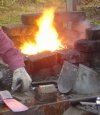- Joined
- Aug 12, 2007
- Messages
- 701
i made a one brick (well technically 5 brick) forge out of 5 pieces of fire brick i bought. with this purchase i also bought a propane torch (a benchmark, nothing special) the forge was made by tying the four pieces together with wire (made a square basically, with a hole in the side for a propane torch and three 1/2 inch holes in the back for ventilation) i tested it out on a small piece of steel and found that it only got the steel cherry red when i placed the steel in the path of the flame. and cooled down as soon as i pulled it away.
so my question is...
how long should i heat the forge before i stick the knife in? the first attempt i was a bit excited to try it so i did go a bit fast and just fired it up waited 15 minutes then stuck in the steel.
just curious to know if i need a better torch (more heat etc.) or do i just have to wait longer for the forge to heat up.
i realize that it would be easier to explain all of this with a picture, but sadly my camera's USB cable is MIA...
im writing this on my way out, if the topic has already come up please re-direct me
thanks
so my question is...
how long should i heat the forge before i stick the knife in? the first attempt i was a bit excited to try it so i did go a bit fast and just fired it up waited 15 minutes then stuck in the steel.
just curious to know if i need a better torch (more heat etc.) or do i just have to wait longer for the forge to heat up.
i realize that it would be easier to explain all of this with a picture, but sadly my camera's USB cable is MIA...
im writing this on my way out, if the topic has already come up please re-direct me
thanks


